No edit summary |
No edit summary |
||
| (13 intermediate revisions by 7 users not shown) | |||
| Line 1: | Line 1: | ||
| + | {{for|the stage introduced in ''[[Brawl]]''|Pokémon Stadium 2}} |
||
{{Infobox Stage |
{{Infobox Stage |
||
| − | |location = [[Kanto]] ([[Pokémon]] in Brawl) |
+ | |location = [[Kanto]] (''[[Pokémon]]'' in ''Brawl'') |
| − | |name = Pokémon Stadium |
+ | |name = Pokémon Stadium |
| − | |image = |
+ | |image = {{#tag:tabber| |
| + | Melee/Brawl=[[Image:Pokemonstadium.jpg|250px|Pokémon Stadium]] |
||
| ⚫ | |||
| − | + | {{!}}-{{!}}Ultimate=[[File:SSBU-Pokémon Stadium.png|250px]] |
|
| + | }} |
||
| − | |games = ''[[Super Smash Bros. Melee|SSBM]]''<br/>''[[Super Smash Bros. Brawl|SSBB]]'' |
||
| ⚫ | |||
| − | |hometo = '''Melee'''<br/>[[Pikachu (SSBM)|Pikachu]] (Classic/All-Star)<br/>[[Jigglypuff (SSBM)|Jigglypuff]] (Classic)<br/>[[Pichu (SSBM)|Pichu]] (Classic)<br/>[[Mewtwo (SSBM)|Mewtwo]] (Classic)<br/>'''Brawl'''<br/>[[Pikachu (SSBB)|Pikachu]]<br/>[[Pokémon Trainer (SSBB)|Pokémon Trainer]]<br/>[[Lucario (SSBB)|Lucario]]<br/>[[Jigglypuff (SSBB)|Jigglypuff]] |
||
| + | |universe = {{uv|Pokémon}} |
||
| − | |availability = [[Starter stage|Starter]] (SSBM)<br/>[[Unlockable stage|Unlockable]] (SSBB) |
||
| + | |games = {{GameIcon|SSBM|20px}}{{GameIcon|SSBB|20px}}{{GameIcon|SSBU|20px}} |
||
| ⚫ | |||
| + | |hometo = '''Melee:'''<br/>{{SSBM|Pikachu}} ([[Classic Mode (SSBM)|Classic]] / [[All-Star]])<br/>{{SSBM|Jigglypuff}} (Unlocking / [[Classic Mode (SSBM)|Classic]])<br/>{{SSBM|Mewtwo}} ([[Classic Mode (SSBM)|Classic]])<br/>{{SSBM|Pichu}} (Unlocking / [[Classic Mode (SSBM)|Classic]])<br/>'''Brawl:'''<br/>{{SSBB|Pikachu}}<br/>{{SSBB|Jigglypuff}}<br/>{{SSBB|Pokémon Trainer}}<br/>{{SSBB|Lucario}}<br/>'''Ultimate:'''<br/>{{SSBU|Pikachu}}<br/>{{SSBU|Jigglypuff}}<br/>{{SSBU|Mewtwo}}<br/>{{SSBU|Pichu}}<br/>{{SSBU|Pokémon Trainer}}<br/>{{SSBU|Lucario}}<br/>{{SSBU|Greninja}}<br/>{{SSBU|Incineroar}} |
||
| ⚫ | |||
| + | |availability = [[Starter_stage#Super_Smash_Bros._Melee|Starter]] (''Melee'')<br/>[[Unlockable_stage#Super_Smash_Bros._Brawl|Unlockable]] (''Brawl'')<br/>[[Starter_stage#Super_Smash_Bros._Ultimate|Starter]] (''Ultimate'') |
||
| ⚫ | |||
| ⚫ | |||
| ⚫ | |||
| ⚫ | |||
| ⚫ | |||
| + | |music = '''In ''Melee'':'''<br><small>''Pokémon Stadium''<br>''Battle Theme'' ([[Alternate music|Alternate]])</small><br>'''In ''Brawl'':'''<br><small>''Pokémon Stadium (Melee)''<br>'''''Battle Theme (Melee)'''''<br>''Poké Floats (Melee)''<br>'''Bolded track must be unlocked.'''</small> |
||
| − | {{nihongo|'''Pokémon Stadium'''|ポケモンスタジアム|Pokemon Sutajiamu}} is a very interesting level that has a basic stage and four other stages that it transforms into. Announced at [[E3]] 2001, the basic stage is comprised of three platforms; one large platform, and two smaller ones. The large platform is on the bottom is flat with two very small elevations for the sides of the stages. The two small platforms of the basic stage float at the medium between 1/4 and 2/4 for the first platform and 3/4 and 4/4 for the second. The basic stage is physically symmetrical. After a while, which could be from a few seconds to a few minutes, the basic stage will transform into one of the other four stages, as indicated by the jumbo television screen that is showing a program of the match you are currently having. After the change into a different stage, the level always goes back into its original basic stage. The same stage could appear twice in a row, but only after the basic stage interval. |
||
| ⚫ | |||
| ⚫ | |||
| ⚫ | |||
| ⚫ | |||
| + | }} |
||
| + | Announced at [[E3]] 2001, {{nihongo|'''Pokémon Stadium'''|ポケモンスタジアム|Pokemon Sutajiamu}} is a stage debuting in ''[[Super Smash Bros. Melee]]'' and returning in ''[[Super Smash Bros. Brawl]]'' as a [[Past and Melee Stages|Melee stage]] and in ''[[Super Smash Bros. Ultimate]]''. It is commonly referred to as '''Pokémon Stadium 1''' to avoid confusion with its similar successor, [[Pokémon Stadium 2]]. |
||
| ⚫ | |||
| − | The second stage is a forest/jungle area. It is somewhat flat on the main platform. There is a small elevated plateau on the right, it ends about 1/3 of the level through, followed by a flat grass area that goes the rest of the level through. There is also a river a little left of the halfway mark that has a minor depression. There are three aerial platforms of this second stage. One medium sized one halfway of the staged and risen and another one higher than it and to the left. The second platform starts halfway of the first platform. The third and final platform is to the right that is flat and very small. |
||
| + | ==Stage layout== |
||
| − | The third stage is a water level. It is flat on the right side with an elevated left side that depresses back down before the stage ends at the left side. On the smooth right side of the level, there are two aerial platforms. A lower one just left of the halfway mark, and a higher one to the right of it. The thing that makes this stage very memorable is the windmill on the left side. The arms of the windmill spin slowly and you can stand on them, but they will dump you off if you stand on the current lowest arm. |
||
| + | [[File:PS_Melee.png|thumb|left|A battle in the main area in ''Melee''.]] |
||
| + | The basic stage is symmetrical and consists of one large main platform at the bottom and two smaller overhanging soft ones. However, after a varying period of time the basic stage transforms into one of four random variations, turning back to the basic version after a while. The same variation can appear twice in a row, with the basic version always in between. In all variation, under the main platform there is an impassable pillar. |
||
| + | On the background there is a large screen which can display the battle itself, a symbol representing the upcoming variation during a stage transition, or the current standings of players. |
||
| − | The fourth stage is a fire area. The bottom platform is not very flat at all. The middle is a small valley. Where the valley ends on the right, it is flat through the rest of the level. There is one floating platform that follows the elevated plateau for the rest of the level. That floating platform is flat. To the left of the valley in the middle is an unusual shaped obstacle. As soon as the valley ends on the left, there is a strait up elevation that you can not pass through (however some attacks can, that is a good strategy to keep in mind). Most characters need to double jump this hurdle, which you can stand on the top of it. After the platform that is the top of the hurdle, it goes straight down again, but only half way. At a 45 degree angle up and left, there is a medium sized platform that sticks out to the end of the level. It is possible to stand under that 45 degree angle and the platform to the left. |
||
| + | [[File:PS_Woods.jpg|thumb|left|Grass version.]] |
||
| − | The fifth and final stage is a rock/mountain stage. This stage has a very rugged bottom platform, with 5 aerial platforms in the center. Two on the left are very small and attached to the mountain, they are parallel and are flat. The other three on the right are all on top of each other, each with their own different angle. The bottom aerial platform is at a steep angle that touches the ground so that you can walk on it. The mountain itself is the largest part of the stage. The top can be stepped on and the left side of the mountain is a steep drop to the edge of the stage. |
||
| + | The '''Grass''' variation takes place in some kind of forest or park. The main platform has slightly elevated plateaus on both sides. A small stream separates the left plateau and the central area, causing a slight depression. A wooden structure with two platforms, one above the other, occupies the middle-left part of the stage, while in the right part there is a tree whose branches form a third platform. |
||
| ⚫ | |||
| + | [[File:PS_Water.jpg|thumb|left|Water version.]] |
||
| − | ===Songs in [[My Music]]=== |
||
| + | The '''Water''' variation takes place near a pond or lake. The whole right side is occupied by a flat pond, while on the left there is a small elevated pier which slopes down on both its sides. Over the pond, two soft platforms are suspended by water spouts, the right one higher than the left one. |
||
| ⚫ | |||
| − | *''Battle Theme (Melee)'' |
||
| − | *'''''Poke Floats (Melee)''''' |
||
| + | On the left side there is a windmill: its arms spin slowly and can be stood upon, but players on the current lowest arm fall. The arms are soft in ''Melee'' but hard in ''Brawl''. |
||
| − | ==Unlock Criteria== |
||
| ⚫ | |||
| + | [[File:PS_Fire.jpg|thumb|left|Fire version.]] |
||
| ⚫ | |||
| + | The '''Fire''' variation takes place in a burning forest. The center of the main platform is occupied by a small depression. On the left side there is a ruined tree: players can stand on top of it, but, due to its height, often need double jumping to reach its top. From the left side of the tree stems a branch which supports a soft floating platform. |
||
| ⚫ | |||
| ⚫ | While the stage is not specifically based on anything from the Pokémon video game series, it may be a general representation of a Gym. One reference could possibly be from the game ''Pokémon Stadium''. The arenas in ''Pokémon Stadium'' have the Pokéball logo in the center with crowds watching the battle. Another possible origin is from the anime. In the first season, Ash is included in a tournament held at the Indigo Plateau. While there is a general stage, similar to the standard form of the stage, the field can transform into various stages, including Rock and Water, although they are much different than the rock and water forms represented in the stage. [http://www.youtube.com/watch?v=JkjklBSqd00] |
||
| + | On the right side there is a burning shack, the roof of whose porch acts as another soft platform. Note that the fire in the background is purely aesthetical and has no gameplay effect. |
||
| ⚫ | There are two songs for this stage. The primary song first appeared in the title screen of ''Pokémon Red and Blue''. The alternate theme is a mix between wild Pokémon battle theme and the song used when battling a gym leader. Both are from ''Pokémon Gold and Silver'' [http://www.youtube.com/watch?v=sxc_6jwQNu8] |
||
| + | [[File:PS_Rock.jpg|thumb|left|Rock version.]] |
||
| − | ==Character strengths/weaknesses== |
||
| + | The '''Rock''' variation takes place in a canyon near a mine. Its terrain is the most uneven of all versions. The right part is flat and empty, while in the middle there are three soft platforms one above the other, of which the bottom one touches the ground and can be walked up from it. |
||
| ⚫ | |||
| + | |||
| − | ===[[Super Smash Bros. Brawl]]=== |
||
| + | The left side is occupied by a large solid mountain, on whose right side stem two more soft platforms. The walls it creates can cause [[infinite]]s and caves of life. The top of the mountain itself acts as a solid platform. The mountain's left side is almost vertical and ends almost at the right edge of the stage, leaving however a small walkable space. |
||
| ⚫ | |||
| + | |||
| ⚫ | |||
Pokémon Stadium is one of the few stages that people in tournaments have almost never questioned. Many people considered Pokémon Stadium to be the fairest level in [[Melee]] because of the changing ground and the platforms but it isn't too big that a person can camp with projectiles. |
Pokémon Stadium is one of the few stages that people in tournaments have almost never questioned. Many people considered Pokémon Stadium to be the fairest level in [[Melee]] because of the changing ground and the platforms but it isn't too big that a person can camp with projectiles. |
||
In Brawl, the stage is more debatable in its neutrality. The lips at the edge are deceptive, occasionally flustering recoveries from slightly underneath the stage or even regular recoveries away from the stage. There are also a number of walls that appear throughout the alternation, which gives advantages to those characters with wall infinites. It is still otherwise an acceptable counter-pick, should it not be listed as neutral. |
In Brawl, the stage is more debatable in its neutrality. The lips at the edge are deceptive, occasionally flustering recoveries from slightly underneath the stage or even regular recoveries away from the stage. There are also a number of walls that appear throughout the alternation, which gives advantages to those characters with wall infinites. It is still otherwise an acceptable counter-pick, should it not be listed as neutral. |
||
| + | |||
| ⚫ | |||
| ⚫ | |||
| ⚫ | While the stage is not specifically based on anything from the Pokémon video game series, it may be a general representation of a Gym. One reference could possibly be from the game ''Pokémon Stadium''. The arenas in ''Pokémon Stadium'' have the Pokéball logo in the center with crowds watching the battle. Another possible origin is from the anime. In the first season, Ash is included in a tournament held at the Indigo Plateau. While there is a general stage, similar to the standard form of the stage, the field can transform into various stages, including Rock and Water, although they are much different than the rock and water forms represented in the stage. [http://www.youtube.com/watch?v=JkjklBSqd00] |
||
| + | |||
| ⚫ | There are two songs for this stage. The primary song first appeared in the title screen of ''Pokémon Red and Blue''. The alternate theme is a mix between wild Pokémon battle theme and the song used when battling a gym leader. Both are from ''Pokémon Gold and Silver'' [http://www.youtube.com/watch?v=sxc_6jwQNu8] |
||
==Trophy description== |
==Trophy description== |
||
| + | ;Pokémon Stadium |
||
| + | [[File:Pokémon Stadium trophy (SSBM).jpg|thumb|200x200px]] |
||
''[[Pokémon trainer|Trainers]] come from far and wide to congregate at Pokémon Stadiums, the ultimate venues to show off their Pokémon teams. There are many different arenas with varying terrain designs, some of which afford advantages to certain Pokémon. This particular stadium is reserved for huge events and boasts a big screen and spectacular fireworks.'' |
''[[Pokémon trainer|Trainers]] come from far and wide to congregate at Pokémon Stadiums, the ultimate venues to show off their Pokémon teams. There are many different arenas with varying terrain designs, some of which afford advantages to certain Pokémon. This particular stadium is reserved for huge events and boasts a big screen and spectacular fireworks.'' |
||
| ⚫ | |||
==Trivia== |
==Trivia== |
||
*Elemental stage transformations were not present in any of the Pokémon games, rather, they originated in the anime. |
*Elemental stage transformations were not present in any of the Pokémon games, rather, they originated in the anime. |
||
| − | *In |
+ | *In ''Brawl'', Pokémon Stadium is the only [[Melee Stage]] with three songs for [[My Music]] (''Pokémon Stadium (Melee)'', ''Battle Theme (Melee)'' and ''Poké Floats (Melee)''). |
| − | *In Brawl, if one is playing as [[Zero Suit Samus]], the |
+ | *In ''Brawl'', if one is playing as [[Zero Suit Samus]], the jumbotron on the background will still show the name "Samus" instead of "Zero Suit Samus". Interestingly, that also happens in [[Pokémon Stadium 2]]. |
| − | *There is a glitch on the forest level |
+ | *There is a glitch on the forest level in ''Brawl'': walk onto it on the very left where the tree stump is while it is forming, and you will fall through. |
| − | *The |
+ | *The jumbotron in the background shows the fight in a lower picture definition in ''Brawl'' than in ''Melee''. |
| − | *The physics for the water stage's windmill have changed in |
+ | *The physics for the water stage's windmill have changed in ''Brawl'', so now players can't walk, jump, or drop through the blades unless you hold the down button on the Wii Remote or smash down on the control stick. |
| − | *When the stage is about to transform, an icon denoting the element flashes on the screen in the background to alert the players. These icons are said to be derived from the logos on certain cards of the official Pokémon trading card game. In the North American beta of Melee, the icons looked exactly like the ones on the cards. However, for the final version of Melee (and Brawl), the designs were changed to look more realistic (because there is no Rock-type Pokémon Card), although they still appear similar to the originals. |
+ | *When the stage is about to transform, an icon denoting the element flashes on the screen in the background to alert the players. These icons are said to be derived from the logos on certain cards of the official ''Pokémon'' trading card game. In the North American beta of ''Melee'', the icons looked exactly like the ones on the cards. However, for the final version of ''Melee'' (and ''Brawl''), the designs were changed to look more realistic (because there is no Rock-type Pokémon Card), although they still appear similar to the originals. |
| − | *In Brawl, the jumbo television uses a new, clearer font for its display. |
+ | *In ''Brawl'', the jumbo television uses a new, clearer font for its display. |
| − | *When playing a team battle in Brawl, when the jumbo television displays the current leader, only the character with the higher score will have his/her name displayed on the television. In Melee however, the television would show the names of all the players in the team that's winning rather than just the one with the highest score. |
+ | *When playing a team battle in ''Brawl'', when the jumbo television displays the current leader, only the character with the higher score will have his/her name displayed on the television. In ''Melee'' however, the television would show the names of all the players in the team that's winning rather than just the one with the highest score. |
| − | *If using the Master Hand Glitch in Melee and playing on this stage the screen will say Master Hand. |
+ | *If using the [[Name Entry glitch|Master Hand Glitch]] in ''Melee'' and playing on this stage the screen will say Master Hand. |
| − | *If |
+ | **If ''Melee'' is hacked to play as Giga Bowser and if he were to be played on this level, his name on the screen will say "G-Bowser." |
| − | *If the instructions from the trivia note above were performed while using Crazy Hand, the game will actually detect him and load his name on the screen as Crazy Hand. |
+ | **If the instructions from the trivia note above were performed while using Crazy Hand, the game will actually detect him and load his name on the screen as Crazy Hand. |
| + | *In ''Brawl'', if this stage is featured in an [[event match]] (such as in [[Event 8: Go! Triple Finish!|Go! Triple Finish!]]), the jumbotron in the background will not display "SUCCESS" when the player clears an event, but will display "FAILURE" when the player fails an event. This issue also happens in [[Pokémon Stadium 2]] and was fixed for both stages in the PAL version. |
||
| + | *This stage could be considered to have the most significant aesthetic changes in ''[[Super Smash Bros. Ultimate]]''. Most notably, the jumbotron has been remodeled to now be in widescreen (16:9), the stadium lights are closer to the jumbotron, etc. |
||
==See also== |
==See also== |
||
| Line 68: | Line 86: | ||
{{SSBMStages}} |
{{SSBMStages}} |
||
{{SSBBStages}} |
{{SSBBStages}} |
||
| + | {{SSBUStages}} |
||
{{Pokémon universe}} |
{{Pokémon universe}} |
||
| − | [[Category:Stages]] |
+ | [[Category:Past Stages]] |
| − | [[Category:Stages (SSBM)]] |
||
| − | [[Category:Pokémon universe]] |
||
[[Category:Trophies (SSBM)]] |
[[Category:Trophies (SSBM)]] |
||
| − | [[Category:Starters]] |
||
| − | [[Category:Unlockables]] |
||
[[Category:Super Smash Bros. Melee]] |
[[Category:Super Smash Bros. Melee]] |
||
[[Category:Super Smash Bros. Brawl]] |
[[Category:Super Smash Bros. Brawl]] |
||
| ⚫ | |||
Revision as of 04:57, 26 June 2019
- For the stage introduced in Brawl, see Pokémon Stadium 2.
Announced at E3 2001, Pokémon Stadium (ポケモンスタジアム Pokemon Sutajiamu?) is a stage debuting in Super Smash Bros. Melee and returning in Super Smash Bros. Brawl as a Melee stage and in Super Smash Bros. Ultimate. It is commonly referred to as Pokémon Stadium 1 to avoid confusion with its similar successor, Pokémon Stadium 2.
In Melee's All-Star Mode, this stage is played on when the player faces Pikachu and any of its teammates.
Stage layout
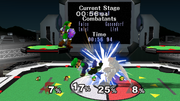
A battle in the main area in Melee.
The basic stage is symmetrical and consists of one large main platform at the bottom and two smaller overhanging soft ones. However, after a varying period of time the basic stage transforms into one of four random variations, turning back to the basic version after a while. The same variation can appear twice in a row, with the basic version always in between. In all variation, under the main platform there is an impassable pillar.
On the background there is a large screen which can display the battle itself, a symbol representing the upcoming variation during a stage transition, or the current standings of players.
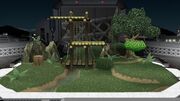
Grass version.
The Grass variation takes place in some kind of forest or park. The main platform has slightly elevated plateaus on both sides. A small stream separates the left plateau and the central area, causing a slight depression. A wooden structure with two platforms, one above the other, occupies the middle-left part of the stage, while in the right part there is a tree whose branches form a third platform.
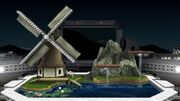
Water version.
The Water variation takes place near a pond or lake. The whole right side is occupied by a flat pond, while on the left there is a small elevated pier which slopes down on both its sides. Over the pond, two soft platforms are suspended by water spouts, the right one higher than the left one.
On the left side there is a windmill: its arms spin slowly and can be stood upon, but players on the current lowest arm fall. The arms are soft in Melee but hard in Brawl.
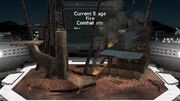
Fire version.
The Fire variation takes place in a burning forest. The center of the main platform is occupied by a small depression. On the left side there is a ruined tree: players can stand on top of it, but, due to its height, often need double jumping to reach its top. From the left side of the tree stems a branch which supports a soft floating platform.
On the right side there is a burning shack, the roof of whose porch acts as another soft platform. Note that the fire in the background is purely aesthetical and has no gameplay effect.
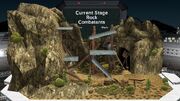
Rock version.
The Rock variation takes place in a canyon near a mine. Its terrain is the most uneven of all versions. The right part is flat and empty, while in the middle there are three soft platforms one above the other, of which the bottom one touches the ground and can be walked up from it.
The left side is occupied by a large solid mountain, on whose right side stem two more soft platforms. The walls it creates can cause infinites and caves of life. The top of the mountain itself acts as a solid platform. The mountain's left side is almost vertical and ends almost at the right edge of the stage, leaving however a small walkable space.
Tournament status
Pokémon Stadium is one of the few stages that people in tournaments have almost never questioned. Many people considered Pokémon Stadium to be the fairest level in Melee because of the changing ground and the platforms but it isn't too big that a person can camp with projectiles.
In Brawl, the stage is more debatable in its neutrality. The lips at the edge are deceptive, occasionally flustering recoveries from slightly underneath the stage or even regular recoveries away from the stage. There are also a number of walls that appear throughout the alternation, which gives advantages to those characters with wall infinites. It is still otherwise an acceptable counter-pick, should it not be listed as neutral.
Origin
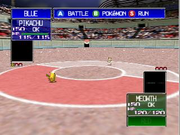
A battle in the game Pokémon Stadium. Note the Pokeball logo in the center and the crowds of people watching the battle.
While the stage is not specifically based on anything from the Pokémon video game series, it may be a general representation of a Gym. One reference could possibly be from the game Pokémon Stadium. The arenas in Pokémon Stadium have the Pokéball logo in the center with crowds watching the battle. Another possible origin is from the anime. In the first season, Ash is included in a tournament held at the Indigo Plateau. While there is a general stage, similar to the standard form of the stage, the field can transform into various stages, including Rock and Water, although they are much different than the rock and water forms represented in the stage. [1]
There are two songs for this stage. The primary song first appeared in the title screen of Pokémon Red and Blue. The alternate theme is a mix between wild Pokémon battle theme and the song used when battling a gym leader. Both are from Pokémon Gold and Silver [2]
Trophy description
- Pokémon Stadium
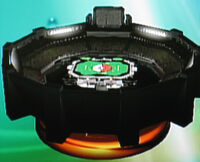
Trainers come from far and wide to congregate at Pokémon Stadiums, the ultimate venues to show off their Pokémon teams. There are many different arenas with varying terrain designs, some of which afford advantages to certain Pokémon. This particular stadium is reserved for huge events and boasts a big screen and spectacular fireworks.
- Pokémon Stadium [3/00]
Trivia
- Elemental stage transformations were not present in any of the Pokémon games, rather, they originated in the anime.
- In Brawl, Pokémon Stadium is the only Melee Stage with three songs for My Music (Pokémon Stadium (Melee), Battle Theme (Melee) and Poké Floats (Melee)).
- In Brawl, if one is playing as Zero Suit Samus, the jumbotron on the background will still show the name "Samus" instead of "Zero Suit Samus". Interestingly, that also happens in Pokémon Stadium 2.
- There is a glitch on the forest level in Brawl: walk onto it on the very left where the tree stump is while it is forming, and you will fall through.
- The jumbotron in the background shows the fight in a lower picture definition in Brawl than in Melee.
- The physics for the water stage's windmill have changed in Brawl, so now players can't walk, jump, or drop through the blades unless you hold the down button on the Wii Remote or smash down on the control stick.
- When the stage is about to transform, an icon denoting the element flashes on the screen in the background to alert the players. These icons are said to be derived from the logos on certain cards of the official Pokémon trading card game. In the North American beta of Melee, the icons looked exactly like the ones on the cards. However, for the final version of Melee (and Brawl), the designs were changed to look more realistic (because there is no Rock-type Pokémon Card), although they still appear similar to the originals.
- In Brawl, the jumbo television uses a new, clearer font for its display.
- When playing a team battle in Brawl, when the jumbo television displays the current leader, only the character with the higher score will have his/her name displayed on the television. In Melee however, the television would show the names of all the players in the team that's winning rather than just the one with the highest score.
- If using the Master Hand Glitch in Melee and playing on this stage the screen will say Master Hand.
- If Melee is hacked to play as Giga Bowser and if he were to be played on this level, his name on the screen will say "G-Bowser."
- If the instructions from the trivia note above were performed while using Crazy Hand, the game will actually detect him and load his name on the screen as Crazy Hand.
- In Brawl, if this stage is featured in an event match (such as in Go! Triple Finish!), the jumbotron in the background will not display "SUCCESS" when the player clears an event, but will display "FAILURE" when the player fails an event. This issue also happens in Pokémon Stadium 2 and was fixed for both stages in the PAL version.
- This stage could be considered to have the most significant aesthetic changes in Super Smash Bros. Ultimate. Most notably, the jumbotron has been remodeled to now be in widescreen (16:9), the stadium lights are closer to the jumbotron, etc.
See also
| ||||||||
| ||||||||||||||||||||||||
| Characters | Pikachu / Pikachu Libre (64 · Melee · Brawl · 3DS/Wii U · Ultimate) Jigglypuff (64 · Melee · Brawl · 3DS/Wii U · Ultimate) Pichu (Melee · Ultimate) Mewtwo (Melee · 3DS/Wii U · Ultimate) Pokémon Trainer (Brawl · Ultimate): Charizard (Brawl · 3DS/Wii U · Ultimate) · Squirtle (Brawl · Ultimate) · Ivysaur (Brawl · Ultimate) Lucario (Brawl · 3DS/Wii U · Ultimate) Greninja (3DS/Wii U · Ultimate) Incineroar (Ultimate) | |
|---|---|---|
| Side Characters | Boss | Rayquaza |
| Mii Fighter Costume | Team Rocket | |
| Background characters | Axew · Azelf · Blastoise · Clawitzer · Cubone · Dragonite · Drifloon · Dugtrio · Electivire · Emolga · Honedge · Hoppip · Hydreigon · Magnezone · Mesprit · Milotic · Moltres · Pidgey · Piplup · Pyroar · Scizor · Shaymin · Skarmory · Snorunt · Steelix · Uxie · Wailord · Whimsicott · Yveltal · Zapdos | |
| Stage Hazards | Chansey · Charmander · Cresselia · Dialga · Electrode · Ho-oh · Manaphy · Palkia · Porygon · Rayquaza · Registeel · Reshiram · Venusaur · Zekrom | |
| Enemies | Chandelure · Cryogonal · Gastly · Koffing · Petilil | |
| Poké Ball Pokémon | Abomasnow · Abra · Alolan Exeggutor · Arceus · Articuno · Beedrill · Bellossom · Bewear · Blastoise · Bonsly · Celebi · Chansey · Charizard · Chespin · Chikorita · Clefairy · Cyndaquil · Darkrai · Dedenne · Deoxys · Ditto · Eevee · Electrode · Entei · Fennekin · Fletchling · Gardevoir · Genesect · Giratina · Gogoat · Goldeen · Groudon · Gulpin · Hitmonlee · Ho-Oh · Inkay · Jirachi · Keldeo · Koffing · Kyogre · Kyurem · Latias and Latios · Lugia · Lunala · Manaphy · Marill · Marshadow · Meloetta · Meowth · Metagross · Mew · Mimikyu · Moltres · Munchlax · Onix · Oshawott · Palkia · Piplup · Porygon2 · Pyukumuku · Raichu · Raikou · Scizor · Snivy · Snorlax · Solgaleo · Spewpa · Starmie · Staryu · Suicune · Swirlix · Tapu Koko · Togedemaru · Togepi · Torchic · Unown · Venusaur · Victini · Vulpix · Weavile · Weezing · Wobbuffet · Xerneas · Zapdos · Zoroark | |
| Stages | Saffron City · Pokémon Stadium · Poké Floats · Pokémon Stadium 2 · Spear Pillar · Unova Pokémon League · Prism Tower · Kalos Pokémon League | |
| Items | Poké Ball · Master Ball | |
| Music | List | List of Music (Pokémon series) |
| Song | "N's Castle Medley" | |
| Collectibles | Trophies | Melee Trophies · Brawl Trophies · 3DS Trophies · Wii U Trophies |
| Stickers | List of Stickers (Pokémon series) | |
| Spirits | List of spirits (Pokémon series) | |
